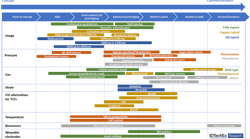IDTechEx report on printed sensors examines wide ranging $3.6B market
The recent IDTechEx report on printed sensors, “Printed and Flexible Sensors 2020-2030: Technologies, Players, Forecasts,” employs a granular approach, in which each sensor technology and potential application is considered independently. It includes chapters on a wide range of printed sensor categories, including organic and hybrid image sensors, piezoresistive and piezoelectric pressure sensors, stretchable strain sensors, temperature sensors, printed electrodes for skin patches, biosensors, ITO alternatives for capacitive touch sensors, and others. The overall market for printed and flexible sensors is forecast to reach $4.5B by 2030, with especially rapid growth in hybrid image sensors that will grow from less than $1M today to around $800M by 2030. The report as a whole includes more than 25 forecast lines covering different technologies and applications and mentions 120 different companies and organizations.
Such an approach reveals a complicated picture, with different technologies at different stages of adoption for different applications.
Three image sensing approaches
IDTechEx divides printed image sensors into three categories: fully organic, organic-on-CMOS hybrid, and quantum dot-on-CMOS hybrid. Fully organic photodetectors (OPDs) can be regarded as organic solar cells operated in reverse, with layers of organic semiconductor printed sequentially onto a flexible substrate. This makes them in principle compatible with large area continuous manufacturing.
The main target application for OPDs is biometric authentication, with one strategy involving placing a large area fingerprint sensor under a display. However, given that fingerprint sensors already exist, including those mounted underneath displays, using OPDs for this application seems to be more the result of a technology push than market need. The value proposition is much clearer for x-ray imaging, where large area sensors are required due to the difficulty of focusing x-rays. However, the market leaders are developing a flexible amorphous silicon-based sensor, filling the niche that OPDs had hoped to occupy.
More promising in our view are hybrid image sensors. These comprise a thin layer of either an organic semiconductor or quantum dots that absorbs light, with charges collected via a CMOS read-out integrated circuit. This approach is transformational, in that it enables light with wavelengths above 1000 nm to be detected by adapting existing CMOS technology – previously this was usually done with very expensive InGaAs based detectors. SWIR imaging meets a genuine market need, for both industrial inspection and most notably for driver assistance systems and autonomous vehicles since light at longer wavelengths is scattered less by dust and fog.
Crucially for commercial adoption, hybrid ‘X-on-CMOS’ detectors can be produced with minimal modifications to existing CMOS fabrication lines, greatly reducing the barriers to entry. At present, quantum dot based hybrid detectors are sensitive to longer wavelengths than their organic hybrid equivalents, and indeed are commercially available. However, organic hybrid detectors are about to be launched in broadcast cameras, where they offer benefits including a spatially variable sensitivity to prevent overexposure and resolving the existing compromise between resolution and using a global shutter since silicon is no longer used to absorb incident light.
Pressure sensing seeks higher value applications
Piezoresistive pressure sensors are long-established, being used in automotive occupancy sensors, electronic musical instruments, and some medical devices. However, such markets are rather mature and subject to commoditization. As such, manufacturers are looking to innovate to differentiate their sensors and access higher-value applications. These innovations, which are at an earlier adoption stage than established single point pressure sensors, include ‘3D-touch’ track pads that monitor pressure as well as position, hybrid piezoresistive/capacitive sensors, and even translucent/transparent detectors. Adding additional functionality increases the required sensor area in a device and the cost per area. The challenge is finding applications in which pressure sensing capability meets a genuine market need since capacitive trackpads and switches are so well established.
Printable piezoelectric sensors, in which variation in applied voltage and dimensions are coupled, can be pressure sensing. There are two competing technologies, either specialty polymers or a ceramic containing composite, of which the former is slightly more established. Both are at a much earlier adoption level than piezoresistive sensors and are thus unlikely to directly compete with the more mature technology in the same application spaces. Instead, they are targeting high-frequency vibration sensing, for which piezoelectric sensors are far better suited than piezoresistive counterparts. However, thus far manufacturers have had more traction in applications that use printable piezoelectric materials as actuators.
ITO Replacement Materials
Another application with multiple competing technologies at different adoption stages is transparent conductors, used primarily as an ITO substitute for capacitive touch screens. This is desirable since ITO is brittle, and thus not compatible with foldable/flexible displays. Furthermore, ITO on PET only has a moderate conductivity.
Silver nanowire (AgNW) have had a long commercialization journey, which has spanned more than 15 years and witnessed many dramatic ups and downs. Previously, AgNWs were adopted in large-area touch displays and today they are appearing in more products such as flexible displays. Hybrid metal mesh was also adopted on table-sized touch displays but has struggled to break into larger size applications. Fully printed metal mesh also continues to make progress, especially in narrowing the linewidth with narrow web printing, although this remains a difficult market overall.
Other materials for transparent conductive films, notably carbon nanotubes and graphene, are earlier in their adoption cycle. The challenge for these technologies is that they are competing not only with ITO but also with the more developed options of silver nanowires and printed metal mesh. This makes it difficult for them to establish a clear value proposition, regardless of their conductivity/ haze ratio.
Wearable electrodes for continuous monitoring
A major trend in the healthcare/wellness/fitness space is the rise of continuous monitoring. Rather than taking isolated readings, either at home or at the doctor’s, continuous monitoring enables biological parameters such as temperature and heart rate to be read continuously. Coupled with appropriate software, this will reduce the need for doctor visits, enable earlier diagnosis, and monitor fitness levels during exercise.
Monitoring heart rate and performing electrocardiograms and other measurements, of muscle activity, for example, requires electrodes. At present, these are primarily based on a rigid metal snap with an electrolytic gel. However, such an approach is not well suited for long-term wearing and thus printed electrodes are gaining ground. An additional driver for adoption is that wearable devices will increasingly become more integrated and flexible, with circuitry printed and even mounted directly onto flexible and even stretchable substrates. Printing the electrodes enables them to be deposited along with the interconnects, reducing manufacturing complexity, while placing ICs onto flexible substrates enables their superior processing capability to be utilized. Flexible circuits comprising both printed and placed functionality are termed flexible hybrid electronics (FHE). This rapidly emerging technology is forecast to exceed $3B by 2030 and is extensively analyzed in the recent IDTechEx report “Flexible Hybrid Electronics 2020-2030: Applications, Challenges, Innovations and Forecasts.”
IDTechEx believes that wearable electrodes are likely to be adopted in medical skin patches before smart clothing, despite the regulatory barriers associated with medical devices. There is a much greater market pull for wearable skin patches with printed electrodes since they offer genuine medical advantages such as easier use outside a hospital and greater patient comfort. Furthermore, a fully integrated skin patch can command a much higher price in a medical setting than similar monitoring technology in a wellness/lifestyle context. Employing printed electrodes in smart clothing also introduces concerns about longevity, since the entire garment would be redundant if electrode/circuitry failed.
The complete picture
It is thus clear that the printed sensor landscape is highly varied, comprising a wide range of technologies that address many applications. Understanding the prospects of each emerging technology depend on the market need, barriers to entry, and the extent to which it offers a clear value proposition over alternatives. Generalizing over a single category of printed sensors loses much of this complexity.
The new report from IDTechEx, “Printed and Flexible Sensors 2020-2030: Technologies, Players, Forecasts,” provides an extensive overview of the diverse underlying technologies and applications of printed and flexible sensors, covering all the technology and application categories in the above chart. By profiling more than 50 companies, IDTechEx map the commercial adoption prospects and challenges for each technology and develop granular market forecasts that span all printed sensor types, technologies and applications. Our market forecasts cover 30 applications/technologies and are provided in both revenue and printed area.
Latest from Financials

Leaders relevant to this article:




